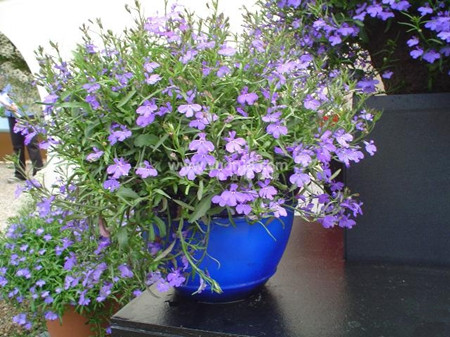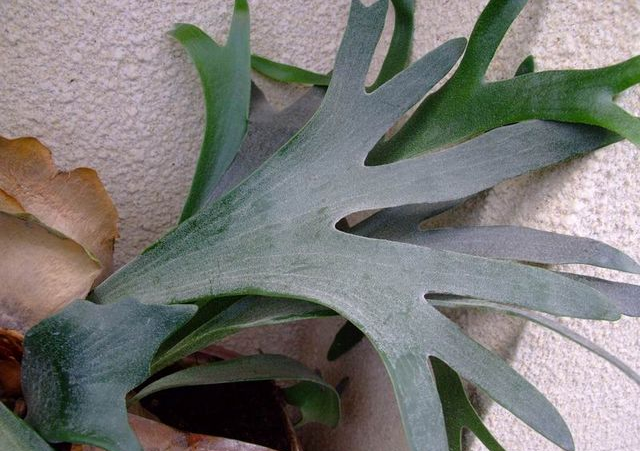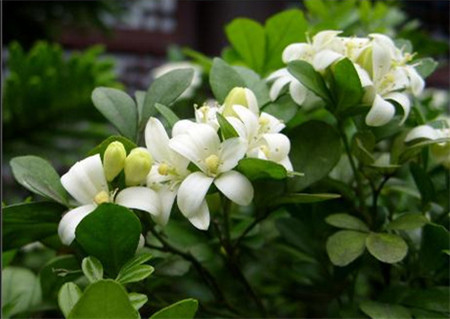Herbal flowers suitable for autumn sowing
Most real flower friends like to sow their own seeds. When the hand-cultivated flowers are presented to relatives and friends, there is a kind of pride in the bottom of my heart. Among the herbaceous flowers, many of the perennial flowers and perennial herbs use the method of sowing in autumn to cultivate flower seedlings. Here are some herbaceous flowers suitable for family balcony, courtyard sowing and cultivation, and good flower viewing effect.

Hanging half of the lotus name hanging six times the profit, originally from South Africa. There are fancy words such as "pity" and "sympathy". The natural flowering period is from summer to autumn. It takes 14-16 weeks from sowing to flowering. Sowing requires that the cold-tolerant varieties should be sowed in autumn from September to October, sowing a mixture of rotten leaf soil, culture soil and fine sand with 24000 seeds per gram, the seeds are small and like light, there is no need to cover the soil after sowing, and the suitable temperature for germination is 18 degrees Celsius-21 degrees Celsius, and germinate 3 weeks after sowing. At seedling stage, the managed seedlings were transplanted once when they had 2-3 true leaves, and when 6-7 leaves were planted or potted. 8 cm-10 cm pots were used for pot cultivation and 10 cm-15 cm pots were used for hanging basket cultivation, with 3 seedlings per pot. A mixture of fertile garden soil and peat soil. Keep the basin soil moist during the growing period to prevent excessive wetting or dehydration. Fertilize once a month.
The name "Doucai" is Lou Douhua, which is originally from Europe. There are fancy words such as "frankness", "worry" and "victory". Natural flowering period from late spring to midsummer. It takes 5-6 months from sowing to flowering. Sowing requires sowing from September to October in autumn or sowing immediately after the seed is mature, the optimum temperature for germination is 18 degrees Celsius-21 degrees Celsius, and 5-4 after sowing. If the temperature is too high, it will not sprout. The first year of sowing seedlings blossomed. When the seedling height was 8 cm-10 cm, the seedlings were planted in a pot of 15 cm-18 cm. A mixture of rotten leaf soil, culture soil, and coarse sand. Sensitive to water, it is necessary to keep the soil moist and high air humidity during the growing period, and shade in summer. Fertilize once a month during the growing period.
Goldfish grass, known as Dragon head Flower, is native to the Mediterranean region. At present, all the cultivated varieties of hybrids are sold in the market. The natural flowering period is from summer to autumn. It takes 21-22 weeks from sowing to flowering. Sowing requires sowing in the south of the Yangtze River from September to October, sowing the mixed substrate of rotten leaf soil, culture soil and fine sand, like light, sowing, not covering after sowing, the appropriate temperature for germination is 21 degrees Celsius, and germinate one week after sowing. Seedling management seedling growth temperature of 10 degrees Celsius-16 degrees Celsius, 6 weeks after planting 10 cm pot, basin soil with a mixture of fertile garden soil, peat soil and sand. Fertilize once every semimonthly during the growing period. Autumn sowing what flowers are better autumn has quietly come to us, autumn sowing, seedlings overwintering, the following spring and summer flowering, fruiting, and then withered, so it is also called autumn sowing flowers. Many florists asked what kind of flowers should be sown this season. The following Zuihua Network will answer this question for you. Such as goldfish grass, pansy, osmanthus fragrance, kale, calendula, daisy, bluebell, carnation, short snow wheel, cornflower, evening primrose, freesia, dry golden lotus, Platycodon grandiflorum and so on. Goldfish grass (alias: dragon head flower, lion flower, dragon mouth flower, ocean color sparrow), goldfish grass is a perennial herb, often used for annual or biennial flower cultivation. Plant height 20-70 cm, leaf blade oblong-lanceolate. Raceme, Corolla tubular lip-shaped, base dilated into a sac, upper lip erect, 2-lobed, lower lip 3-lobed, developing external curvature, with white, light red, deep red, flesh color, dark yellow, light yellow, yellow-orange and other colors. Pansy tricolor (alias: human face flower, cat face flower, Yang butterfly flower, butterfly flower, ghost face flower) is hardy and likes cool. It develops well under the condition of day temperature 15-25 ℃ and night temperature 3-5 ℃. If the daily temperature is more than 30 ℃, the flower bud disappears or does not form petals. The influence of sunshine length on flowering is greater than that of light intensity, poor sunshine and poor flowering. A neutral loam or clay loam that likes to be fertile, well drained and rich in organic matter. It is a perennial flower, often cultivated as a biennial plant. Platycodon grandiflorum (alias: Platycodon grandiflorum, Platycodon grandiflorum Mode of reproduction: sowing in autumn or early winter. Freesia (freesia, alias fragrant orchid, small calamus orchid, evening fragrant jade, wheat orchid, etc., for Iridaceae bulbous flowers.) Perennial herbs. The bulb is conical. Leaves linear, distichous alternate, helicoid inflorescences oblique, flowers narrowly funnelform. The main varieties are lilac "Blue Sister", bright yellow "cream cup", red "fast red", white "beautiful" and orange "Spring Day" and so on. Nelumbo nucifera (alias: dry lotus, cold lotus, golden lotus, dry lotus, cold golden lotus, big cardinal), also known as golden lotus, dry lotus, is a perennial fleshy herbaceous flower of the family Trollius. Originated in South America, sexual love warm, humid, avoid summer high temperature and extreme heat, not resistant to waterlogging, very easy to cultivate. It can be cultivated perennially in the south of China, while in North China, it is sown in autumn and cultivated indoors in pots, as spring flowers to make them bloom during New Year's Day and Spring Festival. Cornflower, at first, felt that it was not easy to grow, but unexpectedly, after sowing the seeds, the sprouting rate was quite high. However, leafminers like to eat its leaves. As soon as they are found, they should be eliminated immediately, otherwise they will be contagious. The flowers are very beautiful. Autumn is the season when chrysanthemums are in full bloom, and some chrysanthemum exhibitions are held in many parks and public places. In fact, flowerpots are also very beautiful. It's easy to grow live ones. I don't know if it means something bad. But it's enough to just enjoy it. Pineapple has small, black seeds, but it germinates quickly. It is suitable for beginners to grow flowers. When I was young, pineapple was also called star flower. It was planted, climbed a lot of vines, and opened a lot of small flowers. A beautiful, fresh smell. If the zinnia is sown, the germination rate is very high. What I sow has basically sprouted, and the flowerpot is larger, and if the soil is more fertile, it can grow a big tree and open from the end of summer to autumn. You'll know after you plant it. The roots under Zhu Dinghong are like garlic or onions, and there are only a few thick and large leaves. Small ones will grow next to this kind of plant for a long time. Blooming is like a unique flower, but the color is very bright and beautiful. Red calamus is a very good species. I put it on the balcony. The high temperature of close to 40 °in summer is still good. It did not freeze to death in winter. All of a sudden, it is full of pink flowers, clean and beautiful. Sunflowers are usually sown in spring, but they can also be planted in autumn. It is also possible to sow seeds, or pick a branch casually, insert it into the soil, often water it, and live. If the soil is fat, it can grow a full basin. Through the introduction of this article, flower friends who want to sow seeds can refer to it. If you want to know more about home gardening, please continue to follow Zuihua net. Planting methods of herbaceous flowers
Herbaceous flowers have the characteristics of high culture coefficient, fast growth and bright colors, so they are important materials for flower bed layout. The grass flowers commonly used in the May 1st flower beds in Fangshan area of Beijing are a string of red flowers, marigold, petunia, cold chrysanthemum, Yu Mei and so on. From September 2009 to May 2010, the author used different culture and seedling methods to cultivate marigold and petunia used in May 1st flower bed in Fangshan Garden Institute.
Planting materials and methods of grass flowers
Materials
The seeds of Petunia were collected by the base in the autumn of 2008, and the seeds of marigold were domestic F1 seeds purchased. The cuttings used in Petunia are twigs of the year.
Method
The seedling growth and plant flowering were observed and recorded in the open field combined with greenhouse cultivation in this garden, and the seedling raising effects of different culture materials and seedling techniques were compared.
Experiment on staged sowing of marigold
Sow marigold at three different times. The first was on November 15, 2009, the second on December 1, 2009, and the third on December 15, 2009.
The sowing methods are all pot sowing.
The soil is the old basin soil sifted and filled into the seedling shallow basin, flatten the topsoil, then spread the seeds evenly, the soil is about 3 mm thick, soak the basin with water at the bottom of the basin, cover with glass and put it in a shady place to be germinated.
After the seeds germinated, when the seedlings grew a pair of true leaves, the seedlings were transplanted into the nursery apparatus, and the row spacing was 5 cm × 5 cm. The seedlings were planted in the basin when they grew up, and the size of the basin was 15 cm × 10 cm. The basin soil was made from the mixture of old basin soil and cow dung according to 2: 1. Control watering at the seedling stage, dry and wet, to prevent overgrowth. Apply liquid fertilizer every 15 days, turn the pot once a week, and weed in time. In order to promote the multi-branching and pregnant buds of the plant, the heart should be picked in time. After the buds grow, in order to control the florescence, the buds that grow prematurely should be removed.
Comparative experiment on sowing and cutting of Petunia on November 4, 2009. The flower seeds were picked in the garden in the autumn of 2008, the soil was sifted and filled into the seedling shallow basin, the topsoil was flattened, and then the seeds and soil were mixed and sowed evenly without covering the soil. The pot bottom was soaked with water, covered with glass and placed in a shady place to be germinated.
The seedlings grow two cotyledons and the seedlings begin to grow when the true leaves are not unfolded. When a true leaf is grown, it is transplanted in a plastic nursery device, and the row spacing is 2cm × 2cm. On February 19, 2010, the transplanted petunia was potted for the first time, and the pot size was 10 cm × 6 cm. The potted soil was made of garden soil, rotten leaf soil and cow dung in the ratio of 4: 2: 1. More than a month later, the basin was changed for the second time, and the specification of the basin was 15 cm × 10 cm. The basin soil was made of garden soil, rotten leaf soil and cow dung according to 4: 2: 1.
Cuttings on November 4, 2009. Cut twigs from the flowers of the year as cuttings, the cuttings are 2.5 cm long, insert the last section into vermiculite, press it with your hands, spray through water and put it in a shady place. After rooting, it was put on the basin on January 8, 2010, and the specification of the basin was 10 cm × 6 cm. When the basin was changed on March 20, the size of the basin was 15 cm × 10 cm. The soil used in the basin was mixed with garden soil, rotten leaf soil and cow dung according to 4: 2: 1.
The daily maintenance and management of the two methods are similar, that is, keep moist, but not too much watering, so as to avoid excessive growth of stems and leaves. Apply more phosphorus and potassium fertilizer and less nitrogen fertilizer. The leaves of seedling stage were sprayed with potassium dihydrogen phosphate twice and irrigated once every half month after planting and maintenance. The heart was picked twice, the first on February 22, 2010, and the second on March 11.
Results and Analysis of Grass Flower planting
According to the results of marigold experiment, the seedling formation time of marigold at different sowing time was observed in order to shorten the breeding period of marigold. The data showed that the plants blooming on time before the festival could be obtained by sowing at three different times, and there was little difference in plant height, crown width, flower color and flower quantity when the flowers were in full bloom. The plants of late sowing are higher than those of early sowing, which may be related to the higher indoor temperature and the overgrowth of plants. Therefore, the room temperature should be controlled when planting in order to make the plant more robust.
The results show that the sowing time of marigold can be postponed to the middle of December, and it can also be guaranteed to blossom before International Labour Day the following year, and grow well.
The results of petunia test showed that the seeds germinated one week after sowing, germinated neatly, and the germination rate was 90%. After potting, the flower bud was seen in mid-late March 2010, and it was in full bloom on April 28, and the flower color was complex. The callus began to grow 10 days after cuttings, and took root one after another after 15 days, with a rooting rate of 96%. Buds appeared on March 15, 2010, bloomed on April 25, and the flowers and colors returned to color.
Petunia sowing and cutting were carried out on the same day, although the flowering period was different, and the cutting was two or three days earlier than sowing, the seedlings bred by the two methods could open on time before the festival. There was no significant difference in plant height, crown width, flower color and flowering quantity between sowing and cutting seedlings. The seeded Petunia seedlings are short and grow slowly at the seedling stage, with a plant height of only 2.1 cm after more than two months from germination to the first pot; cutting Petunia rooting slowly, but the rooting rate is high. The cutting petunia is more than a month apart from the cutting to the first pot, and the plant is relatively large and easy to manage. it is necessary to control water and fertilizer in the later growth stage to prevent overgrowth. Therefore, it is better to cultivate petunia by cutting in production.
Conclusion according to the above experiments, under the current cultivation conditions in Fangshan, Beijing, petunia has a good effect of raising seedlings by cutting, which has the characteristics of simple material acquisition, high rooting rate, shortening cultivation period and so on. When marigold is sown from mid-November to mid-December, festive seedlings can be obtained with little difference in quality.
- Prev

Breeding methods and principles of Ceratopteris Dryopteris
[ramet time]: it is best to do it after the soil is thawed in early spring (February, March). [ramet method]: take the mother plant out of the flowerpot, shake off the excess pot soil, separate the root system as far as possible, and cut it into two or more plants with a sharp knife.
- Next

The Cuttage method of Corydalis chinensis
The propagation methods of night incense mainly include cutting propagation, striping propagation, ramet propagation and seed breeding, and the most commonly used method is cutting propagation. Cuttage propagation can be carried out except in winter, and it is best to cultivate it in sandy loam soil in a warm and humid climate.
Related
- Fuxing push coffee new agricultural production and marketing class: lack of small-scale processing plants
- Jujube rice field leisure farm deep ploughing Yilan for five years to create a space for organic food and play
- Nongyu Farm-A trial of organic papaya for brave women with advanced technology
- Four points for attention in the prevention and control of diseases and insect pests of edible fungi
- How to add nutrient solution to Edible Fungi
- Is there any good way to control edible fungus mites?
- Open Inoculation Technology of Edible Fungi
- Is there any clever way to use fertilizer for edible fungus in winter?
- What agents are used to kill the pathogens of edible fungi in the mushroom shed?
- Rapid drying of Edible Fungi

